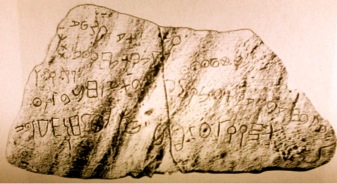The Lost Link: The Alphabet in the Hands of the Early Israelites
We received this post from ASOR Friend and NEA subscriber Brian Colless, and he asked us to pass it along to the readers of the ASOR Blog. We are happy to do so and encourage you to comment on the post. By: Brian E. Colless Massey University, Palmerston North, New Zealand I have just made […]
Using Inscriptions from the Antiquities Market: Polarized Positions and Pragmatic Proposals
By: Christopher A. Rollston Archaeological sites in the Middle East have been ransacked, pillaged, and plundered for many decades. The motivations of the actual pillaging are normally economic: the pursuit of marketable artifacts. That is, the pillagers wish to find objects that can be sold to collectors. Of course, the motivations of the collectors who […]
The Dilemma of Denial: Scholarly Publication Policies and the Illusion of Power
By: Jonathan Rosenbaum President Emeritus, Gratz College For generations, academic journals have been deemed the appropriate venue for the initial publication of ancient inscriptions and artifacts. Nevertheless, last fall, the New York Times became the source of an editio princeps when it announced the discovery of a “faded papyrus fragment” that seemed to be “first […]
From History and Myth, Anatolians in Mycenaean Greece
By: Josh Cannon, University of Chicago The Late Bronze Age (LBA) of Anatolia is a period that has been described to us through history and myth. The history of LBA Anatolia comes primarily from the Hittites, who actively created and maintained records. Written in cuneiform, these records provide us with a wealth of information ranging […]
FORGING HISTORY: MOTIVES, METHODS, AND EXEMPLARS OF FORGED TEXTS [1]
EnglishEnglishFrenchPowered by TranslateChristopher A. Rollston, Toyozo Nakarai Professor of Old Testament and Semitic Studies, Emmanuel Christian Seminary I. MOTIVATIONS FOR THE PRODUCTION OF FORGERIES Forgeries have been produced for many centuries (Metzger 1997, 125-139; Rollston Ehrman) and it would not be prudent to believe that the future shall be different […]
April Theme: Fakes, Looting, and Artifacts Lacking Context
The ASOR Blog is pleased to announce a new “theme” for the month of April—Unprovenanced Artifacts and Possible Forgeries. The ASOR Blog will continue to post other items of interest that are submitted by the ASOR Staff and ASOR Members, but (just like we did in March) we will solicit posts on the “theme” […]
The Response of the Israel Antiquities Authority to the Verdict by the Jerusalem District Court in the Matter of the Forgeries Trial
This morning (Wednesday, March 14) the verdict was published in the prosecution’s case—the State of Israel vs. Oded Golan, Robert Deutsch, et alia—Criminal Case 482/04. [This post is taken from the IAA website and re-posted on the ASOR Blog] In response to the decision by Judge Aharon Farkash of the Jerusalem District Court, the Israel […]
Eric Meyers’ reaction to the verdict in the forgery trial in Israel
Reaction to Golan Acquittal, Professor Eric M. Meyers, Duke University The verdict announced today, March 14, by Judge Aharon Farkash in Jerusalem, acquitting Oded Golan and Robert Deustch of all major charges comes as no surprise. The James ossuary first came into public view some ten years ago in Toronto when a special exhibition was […]
The Talpiot Tomb and the Beatles
EnglishEnglishFrenchPowered by TranslateBy: Mark Goodacre, Dept of Religion, Duke University The current discussion of Talpiot Tomb B, the “patio tomb”, has largely centered on the interpretation of the picture on one of the ossuaries. But Tabor’s and Jacobovici’s argument that this tomb is linked with Jesus and his disciples is related to their earlier claims […]
FEATURED POST by Christopher Rollston: The Probable Inventors of the First Alphabet
The Probable Inventors of the First Alphabet: Semites Functioning as rather High Status Personnel in a Component of the Egyptian Apparatus Christopher Rollston Introduction: For some time, there has been discussion about the social status of those that developed (“inventedâ€) Alphabetic Writing (i.e., elites or non-elites). Therefore, the nuanced discussion between O. Goldwasser
Secrets of The Bible’s Buried Secrets
Contributed by Tristan Barako, Ph.D., Senior Researcher, Providence Pictures When The Bible’s Buried Secrets premiered on PBS this past November, it was NOVA’s most watched show in the past five years, attesting to the enduring interest that biblical archaeology holds for the general public. The two-hour special was produced by Providence Pictures, where I now […]
10th Century BCE Hebrew Inscription Found at Khirbet Qeiyafa
Contributed by Y. Garfinkel (November 5) This summer an extraordinary Semitic inscription was found at Khirbet Qeiyafa. It was uncovered inside the fortified city, near the gate, lying on a floor level of a building. The city existed for a rather short time, within the 10th century BC, thus, the dating of the inscription […]

